Predictors of Hope Among Patients With Cancer in Jordan Article review 2022
VerifiedAdded on 2022/08/29
|6
|1649
|10
AI Summary
Contribute Materials
Your contribution can guide someone’s learning journey. Share your
documents today.
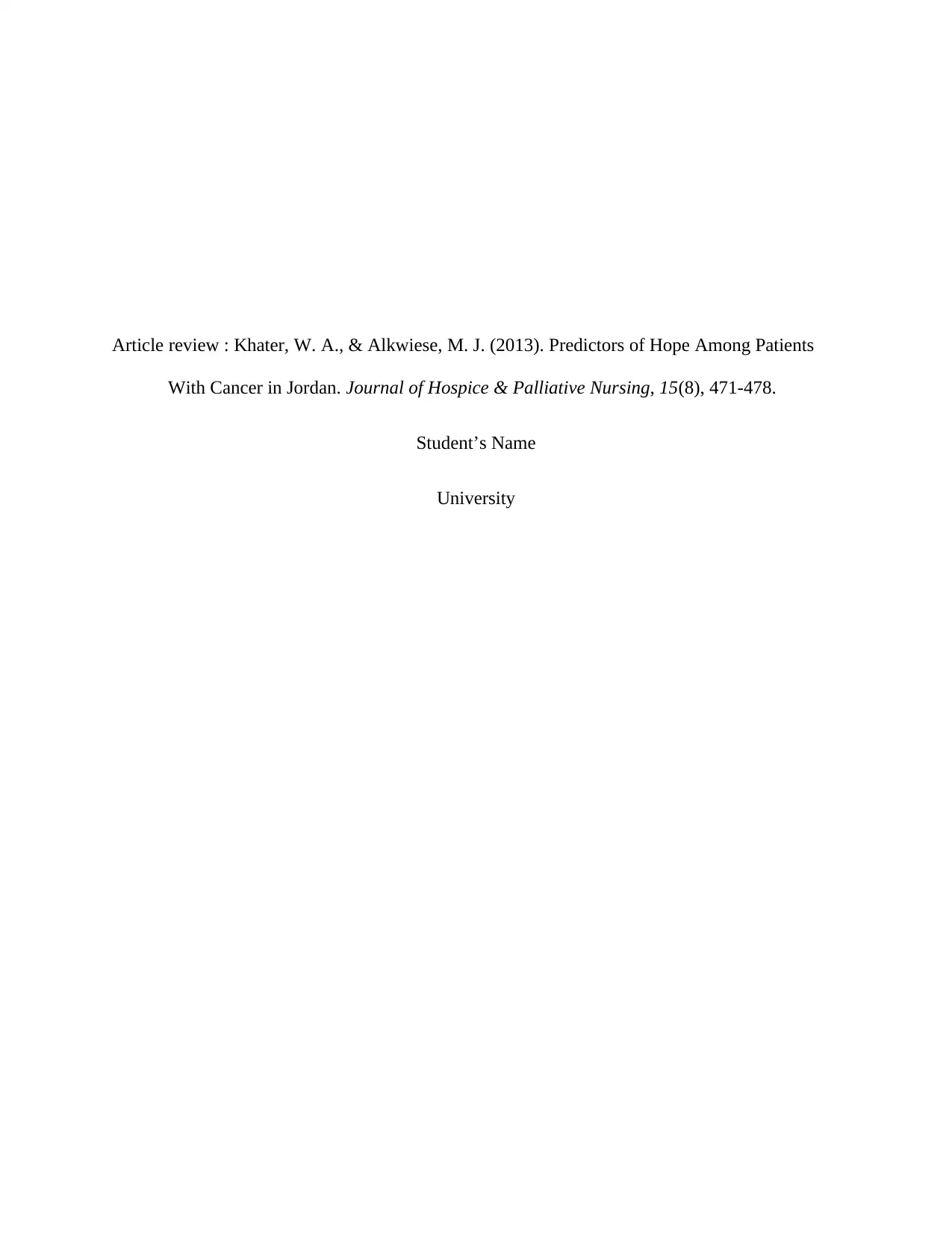
Article review : Khater, W. A., & Alkwiese, M. J. (2013). Predictors of Hope Among Patients
With Cancer in Jordan. Journal of Hospice & Palliative Nursing, 15(8), 471-478.
Student’s Name
University
With Cancer in Jordan. Journal of Hospice & Palliative Nursing, 15(8), 471-478.
Student’s Name
University
Secure Best Marks with AI Grader
Need help grading? Try our AI Grader for instant feedback on your assignments.
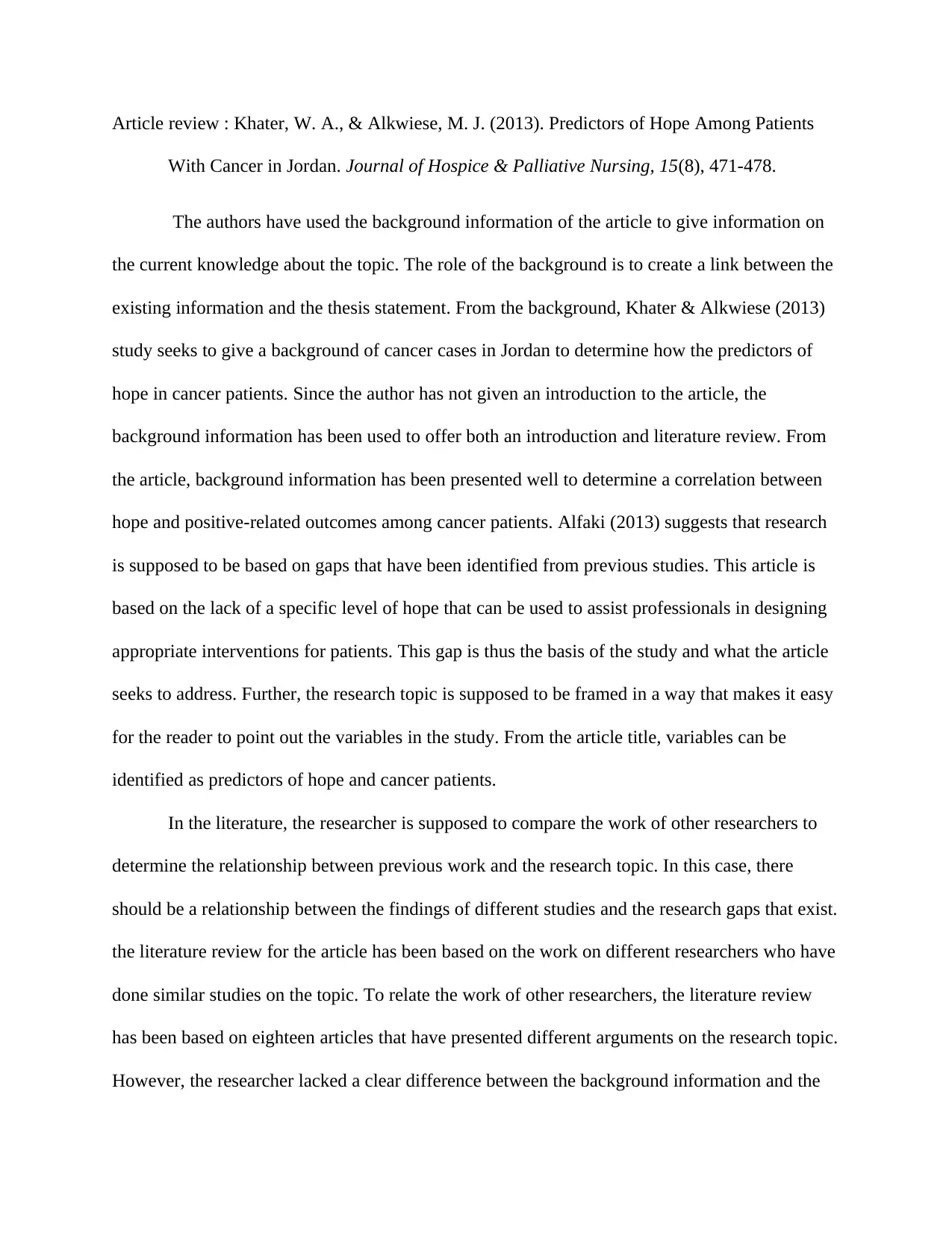
Article review : Khater, W. A., & Alkwiese, M. J. (2013). Predictors of Hope Among Patients
With Cancer in Jordan. Journal of Hospice & Palliative Nursing, 15(8), 471-478.
The authors have used the background information of the article to give information on
the current knowledge about the topic. The role of the background is to create a link between the
existing information and the thesis statement. From the background, Khater & Alkwiese (2013)
study seeks to give a background of cancer cases in Jordan to determine how the predictors of
hope in cancer patients. Since the author has not given an introduction to the article, the
background information has been used to offer both an introduction and literature review. From
the article, background information has been presented well to determine a correlation between
hope and positive-related outcomes among cancer patients. Alfaki (2013) suggests that research
is supposed to be based on gaps that have been identified from previous studies. This article is
based on the lack of a specific level of hope that can be used to assist professionals in designing
appropriate interventions for patients. This gap is thus the basis of the study and what the article
seeks to address. Further, the research topic is supposed to be framed in a way that makes it easy
for the reader to point out the variables in the study. From the article title, variables can be
identified as predictors of hope and cancer patients.
In the literature, the researcher is supposed to compare the work of other researchers to
determine the relationship between previous work and the research topic. In this case, there
should be a relationship between the findings of different studies and the research gaps that exist.
the literature review for the article has been based on the work on different researchers who have
done similar studies on the topic. To relate the work of other researchers, the literature review
has been based on eighteen articles that have presented different arguments on the research topic.
However, the researcher lacked a clear difference between the background information and the
With Cancer in Jordan. Journal of Hospice & Palliative Nursing, 15(8), 471-478.
The authors have used the background information of the article to give information on
the current knowledge about the topic. The role of the background is to create a link between the
existing information and the thesis statement. From the background, Khater & Alkwiese (2013)
study seeks to give a background of cancer cases in Jordan to determine how the predictors of
hope in cancer patients. Since the author has not given an introduction to the article, the
background information has been used to offer both an introduction and literature review. From
the article, background information has been presented well to determine a correlation between
hope and positive-related outcomes among cancer patients. Alfaki (2013) suggests that research
is supposed to be based on gaps that have been identified from previous studies. This article is
based on the lack of a specific level of hope that can be used to assist professionals in designing
appropriate interventions for patients. This gap is thus the basis of the study and what the article
seeks to address. Further, the research topic is supposed to be framed in a way that makes it easy
for the reader to point out the variables in the study. From the article title, variables can be
identified as predictors of hope and cancer patients.
In the literature, the researcher is supposed to compare the work of other researchers to
determine the relationship between previous work and the research topic. In this case, there
should be a relationship between the findings of different studies and the research gaps that exist.
the literature review for the article has been based on the work on different researchers who have
done similar studies on the topic. To relate the work of other researchers, the literature review
has been based on eighteen articles that have presented different arguments on the research topic.
However, the researcher lacked a clear difference between the background information and the
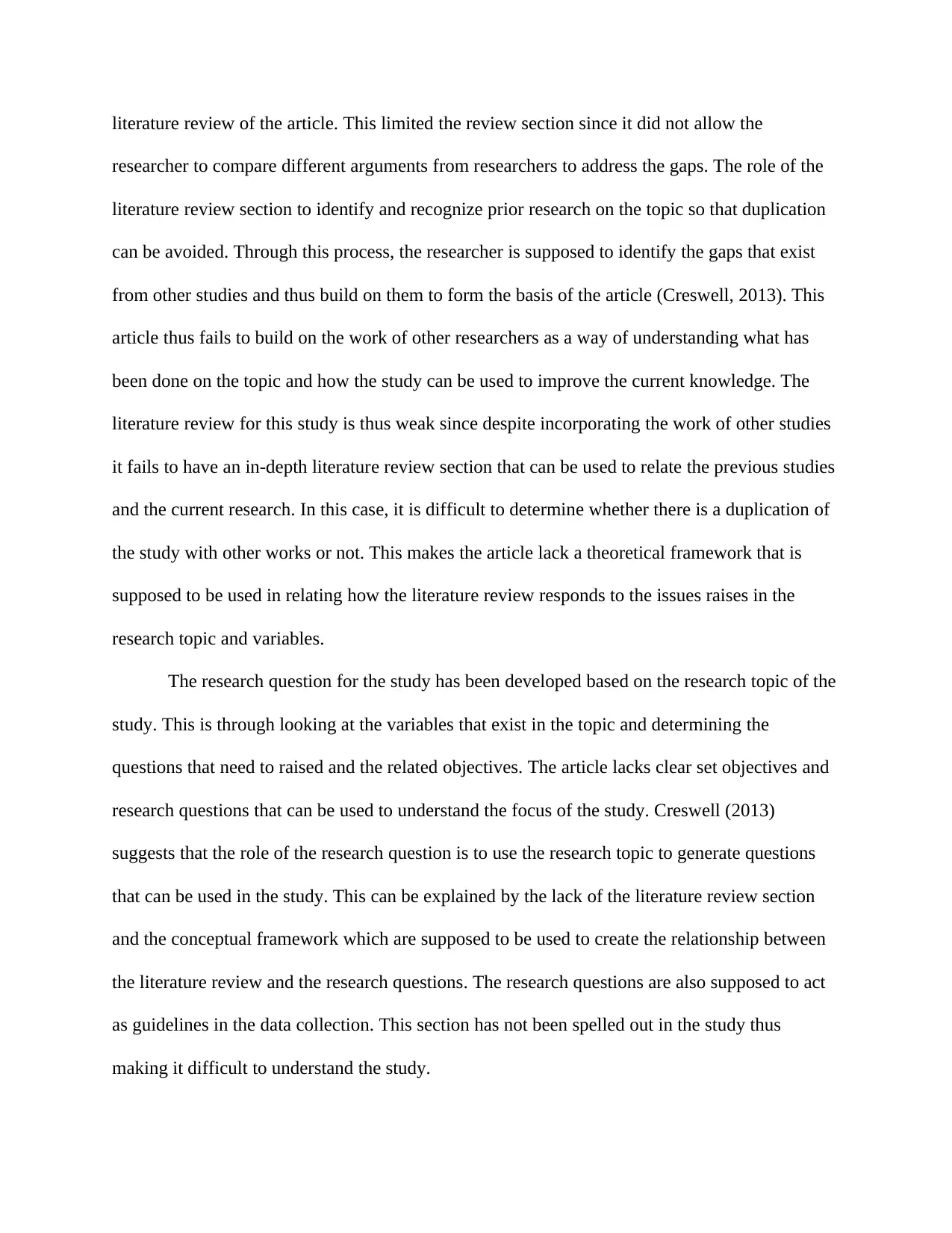
literature review of the article. This limited the review section since it did not allow the
researcher to compare different arguments from researchers to address the gaps. The role of the
literature review section to identify and recognize prior research on the topic so that duplication
can be avoided. Through this process, the researcher is supposed to identify the gaps that exist
from other studies and thus build on them to form the basis of the article (Creswell, 2013). This
article thus fails to build on the work of other researchers as a way of understanding what has
been done on the topic and how the study can be used to improve the current knowledge. The
literature review for this study is thus weak since despite incorporating the work of other studies
it fails to have an in-depth literature review section that can be used to relate the previous studies
and the current research. In this case, it is difficult to determine whether there is a duplication of
the study with other works or not. This makes the article lack a theoretical framework that is
supposed to be used in relating how the literature review responds to the issues raises in the
research topic and variables.
The research question for the study has been developed based on the research topic of the
study. This is through looking at the variables that exist in the topic and determining the
questions that need to raised and the related objectives. The article lacks clear set objectives and
research questions that can be used to understand the focus of the study. Creswell (2013)
suggests that the role of the research question is to use the research topic to generate questions
that can be used in the study. This can be explained by the lack of the literature review section
and the conceptual framework which are supposed to be used to create the relationship between
the literature review and the research questions. The research questions are also supposed to act
as guidelines in the data collection. This section has not been spelled out in the study thus
making it difficult to understand the study.
researcher to compare different arguments from researchers to address the gaps. The role of the
literature review section to identify and recognize prior research on the topic so that duplication
can be avoided. Through this process, the researcher is supposed to identify the gaps that exist
from other studies and thus build on them to form the basis of the article (Creswell, 2013). This
article thus fails to build on the work of other researchers as a way of understanding what has
been done on the topic and how the study can be used to improve the current knowledge. The
literature review for this study is thus weak since despite incorporating the work of other studies
it fails to have an in-depth literature review section that can be used to relate the previous studies
and the current research. In this case, it is difficult to determine whether there is a duplication of
the study with other works or not. This makes the article lack a theoretical framework that is
supposed to be used in relating how the literature review responds to the issues raises in the
research topic and variables.
The research question for the study has been developed based on the research topic of the
study. This is through looking at the variables that exist in the topic and determining the
questions that need to raised and the related objectives. The article lacks clear set objectives and
research questions that can be used to understand the focus of the study. Creswell (2013)
suggests that the role of the research question is to use the research topic to generate questions
that can be used in the study. This can be explained by the lack of the literature review section
and the conceptual framework which are supposed to be used to create the relationship between
the literature review and the research questions. The research questions are also supposed to act
as guidelines in the data collection. This section has not been spelled out in the study thus
making it difficult to understand the study.
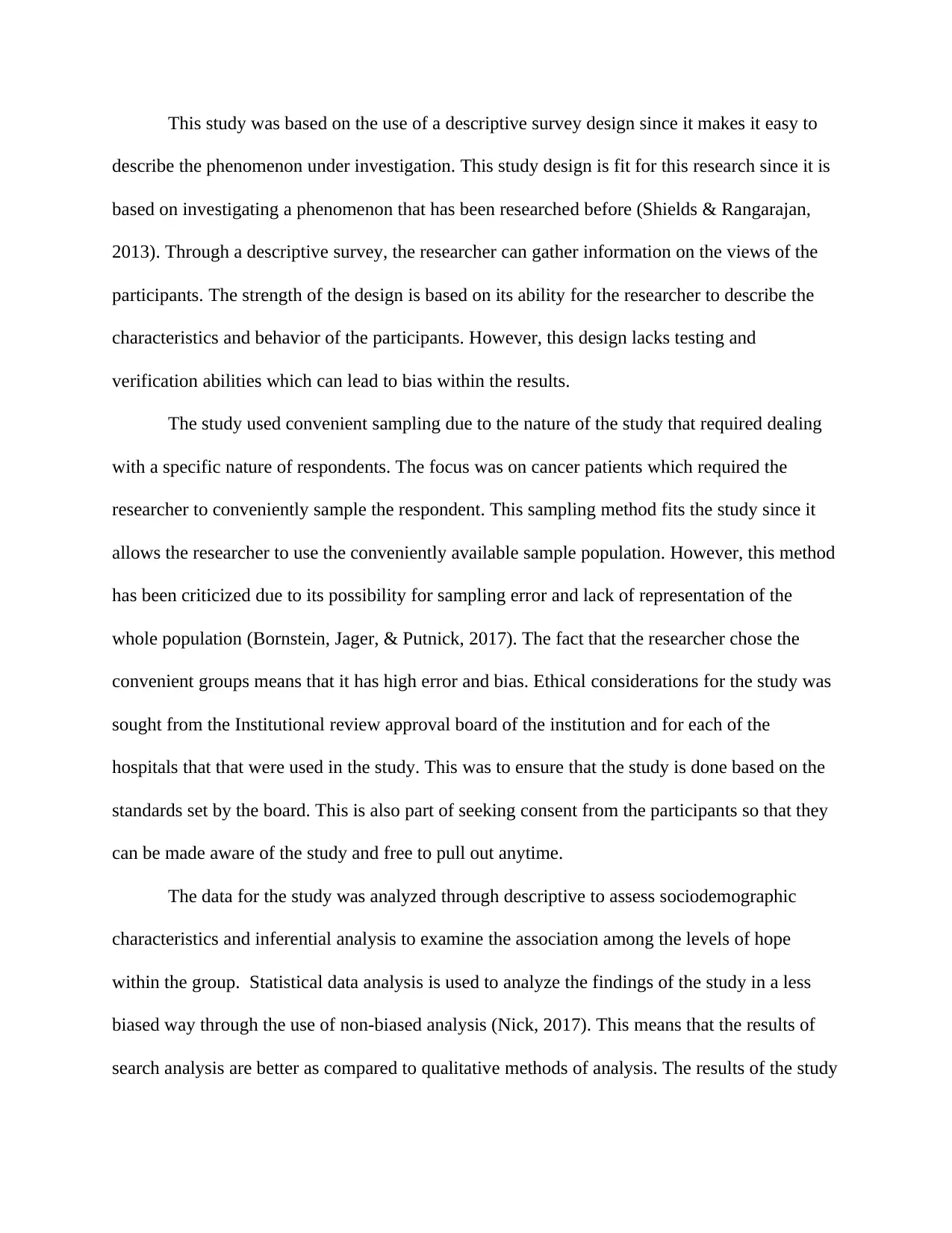
This study was based on the use of a descriptive survey design since it makes it easy to
describe the phenomenon under investigation. This study design is fit for this research since it is
based on investigating a phenomenon that has been researched before (Shields & Rangarajan,
2013). Through a descriptive survey, the researcher can gather information on the views of the
participants. The strength of the design is based on its ability for the researcher to describe the
characteristics and behavior of the participants. However, this design lacks testing and
verification abilities which can lead to bias within the results.
The study used convenient sampling due to the nature of the study that required dealing
with a specific nature of respondents. The focus was on cancer patients which required the
researcher to conveniently sample the respondent. This sampling method fits the study since it
allows the researcher to use the conveniently available sample population. However, this method
has been criticized due to its possibility for sampling error and lack of representation of the
whole population (Bornstein, Jager, & Putnick, 2017). The fact that the researcher chose the
convenient groups means that it has high error and bias. Ethical considerations for the study was
sought from the Institutional review approval board of the institution and for each of the
hospitals that that were used in the study. This was to ensure that the study is done based on the
standards set by the board. This is also part of seeking consent from the participants so that they
can be made aware of the study and free to pull out anytime.
The data for the study was analyzed through descriptive to assess sociodemographic
characteristics and inferential analysis to examine the association among the levels of hope
within the group. Statistical data analysis is used to analyze the findings of the study in a less
biased way through the use of non-biased analysis (Nick, 2017). This means that the results of
search analysis are better as compared to qualitative methods of analysis. The results of the study
describe the phenomenon under investigation. This study design is fit for this research since it is
based on investigating a phenomenon that has been researched before (Shields & Rangarajan,
2013). Through a descriptive survey, the researcher can gather information on the views of the
participants. The strength of the design is based on its ability for the researcher to describe the
characteristics and behavior of the participants. However, this design lacks testing and
verification abilities which can lead to bias within the results.
The study used convenient sampling due to the nature of the study that required dealing
with a specific nature of respondents. The focus was on cancer patients which required the
researcher to conveniently sample the respondent. This sampling method fits the study since it
allows the researcher to use the conveniently available sample population. However, this method
has been criticized due to its possibility for sampling error and lack of representation of the
whole population (Bornstein, Jager, & Putnick, 2017). The fact that the researcher chose the
convenient groups means that it has high error and bias. Ethical considerations for the study was
sought from the Institutional review approval board of the institution and for each of the
hospitals that that were used in the study. This was to ensure that the study is done based on the
standards set by the board. This is also part of seeking consent from the participants so that they
can be made aware of the study and free to pull out anytime.
The data for the study was analyzed through descriptive to assess sociodemographic
characteristics and inferential analysis to examine the association among the levels of hope
within the group. Statistical data analysis is used to analyze the findings of the study in a less
biased way through the use of non-biased analysis (Nick, 2017). This means that the results of
search analysis are better as compared to qualitative methods of analysis. The results of the study
Secure Best Marks with AI Grader
Need help grading? Try our AI Grader for instant feedback on your assignments.
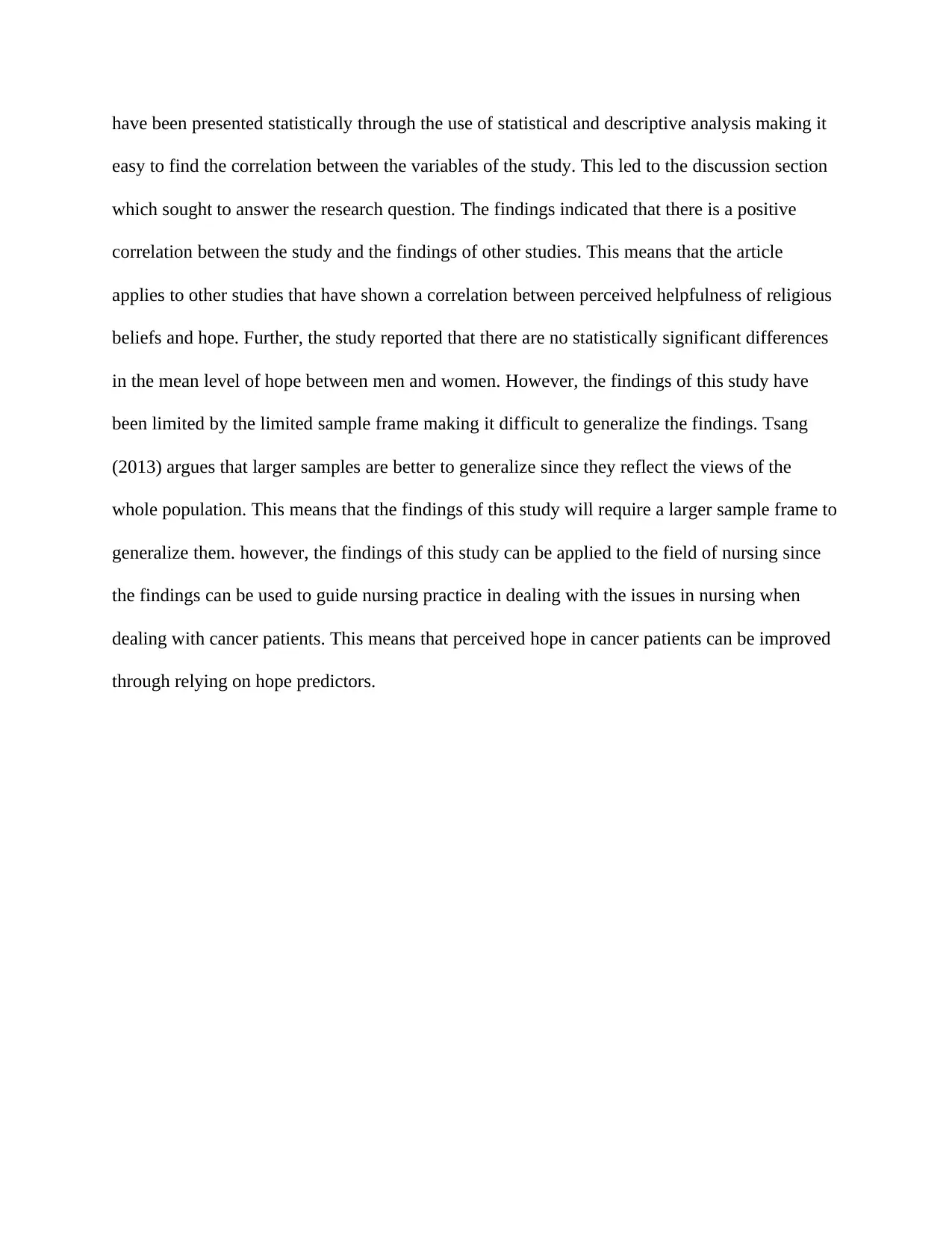
have been presented statistically through the use of statistical and descriptive analysis making it
easy to find the correlation between the variables of the study. This led to the discussion section
which sought to answer the research question. The findings indicated that there is a positive
correlation between the study and the findings of other studies. This means that the article
applies to other studies that have shown a correlation between perceived helpfulness of religious
beliefs and hope. Further, the study reported that there are no statistically significant differences
in the mean level of hope between men and women. However, the findings of this study have
been limited by the limited sample frame making it difficult to generalize the findings. Tsang
(2013) argues that larger samples are better to generalize since they reflect the views of the
whole population. This means that the findings of this study will require a larger sample frame to
generalize them. however, the findings of this study can be applied to the field of nursing since
the findings can be used to guide nursing practice in dealing with the issues in nursing when
dealing with cancer patients. This means that perceived hope in cancer patients can be improved
through relying on hope predictors.
easy to find the correlation between the variables of the study. This led to the discussion section
which sought to answer the research question. The findings indicated that there is a positive
correlation between the study and the findings of other studies. This means that the article
applies to other studies that have shown a correlation between perceived helpfulness of religious
beliefs and hope. Further, the study reported that there are no statistically significant differences
in the mean level of hope between men and women. However, the findings of this study have
been limited by the limited sample frame making it difficult to generalize the findings. Tsang
(2013) argues that larger samples are better to generalize since they reflect the views of the
whole population. This means that the findings of this study will require a larger sample frame to
generalize them. however, the findings of this study can be applied to the field of nursing since
the findings can be used to guide nursing practice in dealing with the issues in nursing when
dealing with cancer patients. This means that perceived hope in cancer patients can be improved
through relying on hope predictors.
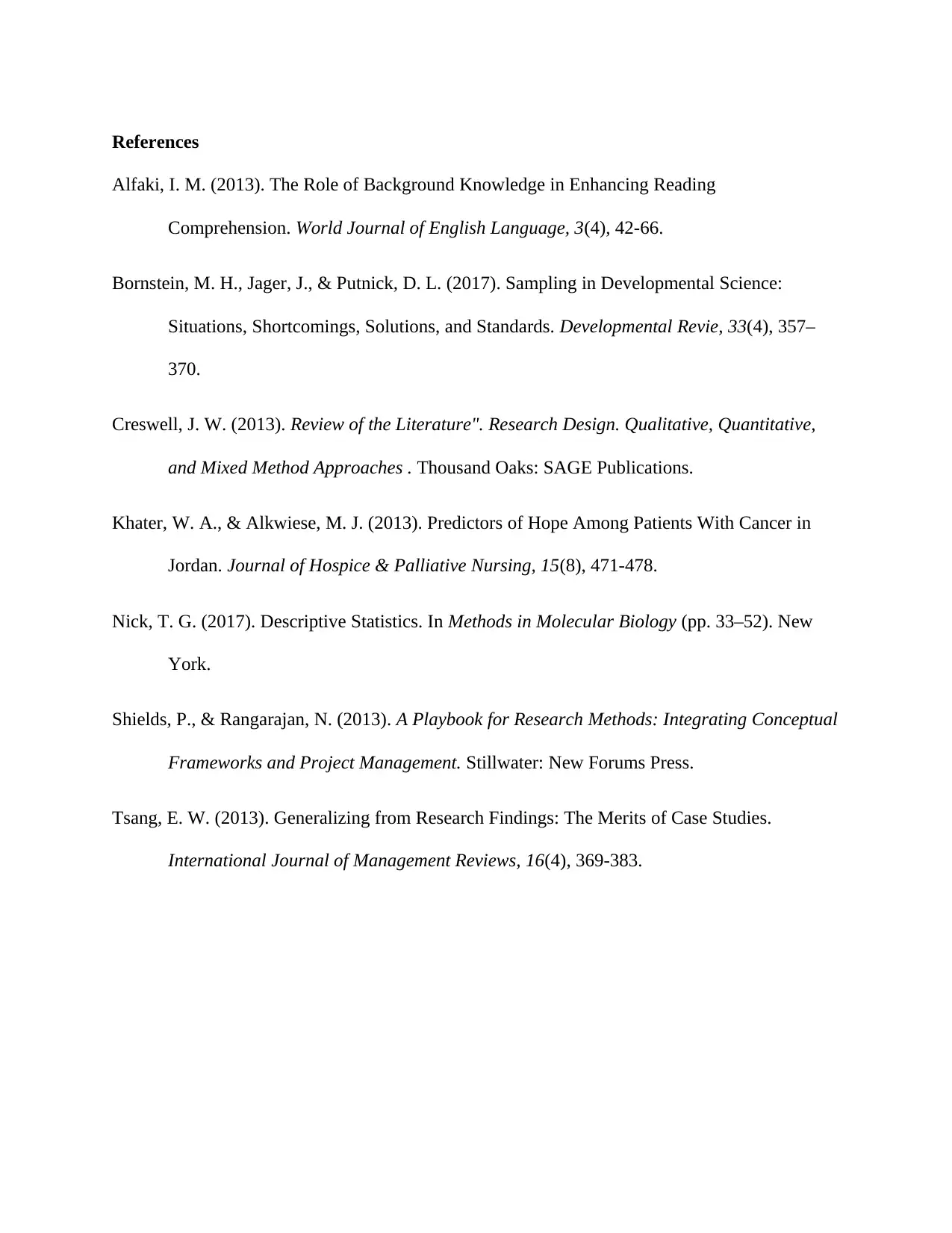
References
Alfaki, I. M. (2013). The Role of Background Knowledge in Enhancing Reading
Comprehension. World Journal of English Language, 3(4), 42-66.
Bornstein, M. H., Jager, J., & Putnick, D. L. (2017). Sampling in Developmental Science:
Situations, Shortcomings, Solutions, and Standards. Developmental Revie, 33(4), 357–
370.
Creswell, J. W. (2013). Review of the Literature". Research Design. Qualitative, Quantitative,
and Mixed Method Approaches . Thousand Oaks: SAGE Publications.
Khater, W. A., & Alkwiese, M. J. (2013). Predictors of Hope Among Patients With Cancer in
Jordan. Journal of Hospice & Palliative Nursing, 15(8), 471-478.
Nick, T. G. (2017). Descriptive Statistics. In Methods in Molecular Biology (pp. 33–52). New
York.
Shields, P., & Rangarajan, N. (2013). A Playbook for Research Methods: Integrating Conceptual
Frameworks and Project Management. Stillwater: New Forums Press.
Tsang, E. W. (2013). Generalizing from Research Findings: The Merits of Case Studies.
International Journal of Management Reviews, 16(4), 369-383.
Alfaki, I. M. (2013). The Role of Background Knowledge in Enhancing Reading
Comprehension. World Journal of English Language, 3(4), 42-66.
Bornstein, M. H., Jager, J., & Putnick, D. L. (2017). Sampling in Developmental Science:
Situations, Shortcomings, Solutions, and Standards. Developmental Revie, 33(4), 357–
370.
Creswell, J. W. (2013). Review of the Literature". Research Design. Qualitative, Quantitative,
and Mixed Method Approaches . Thousand Oaks: SAGE Publications.
Khater, W. A., & Alkwiese, M. J. (2013). Predictors of Hope Among Patients With Cancer in
Jordan. Journal of Hospice & Palliative Nursing, 15(8), 471-478.
Nick, T. G. (2017). Descriptive Statistics. In Methods in Molecular Biology (pp. 33–52). New
York.
Shields, P., & Rangarajan, N. (2013). A Playbook for Research Methods: Integrating Conceptual
Frameworks and Project Management. Stillwater: New Forums Press.
Tsang, E. W. (2013). Generalizing from Research Findings: The Merits of Case Studies.
International Journal of Management Reviews, 16(4), 369-383.
1 out of 6
Related Documents
Your All-in-One AI-Powered Toolkit for Academic Success.
+13062052269
info@desklib.com
Available 24*7 on WhatsApp / Email
![[object Object]](/_next/static/media/star-bottom.7253800d.svg)
Unlock your academic potential
© 2024 | Zucol Services PVT LTD | All rights reserved.





